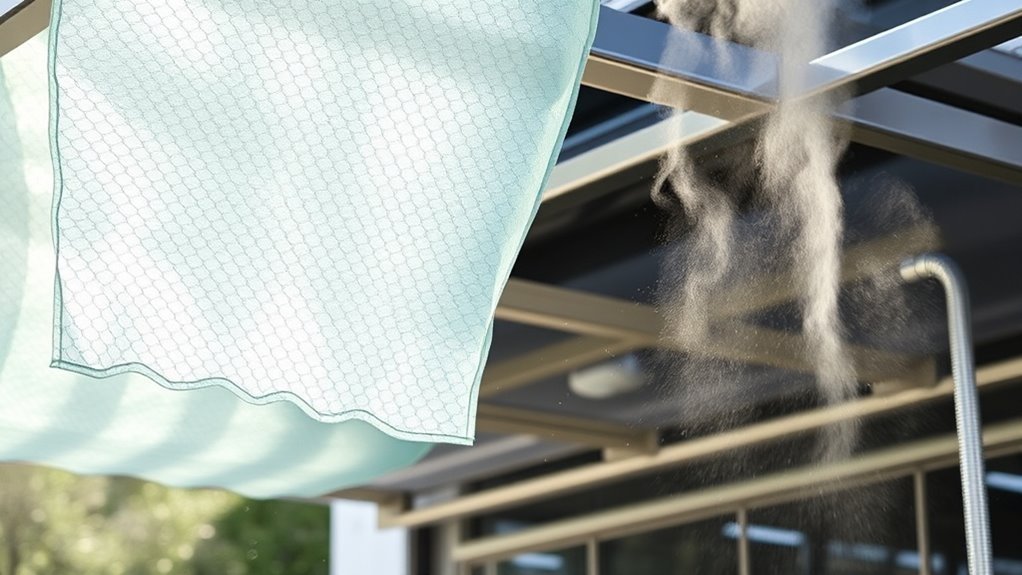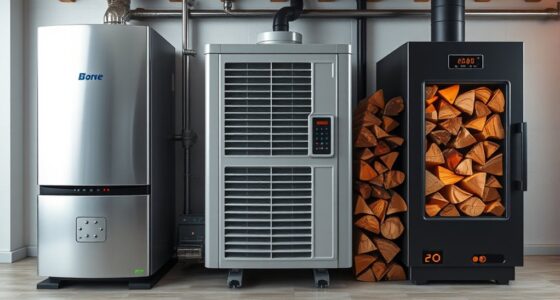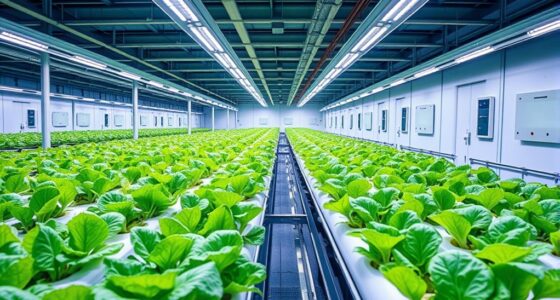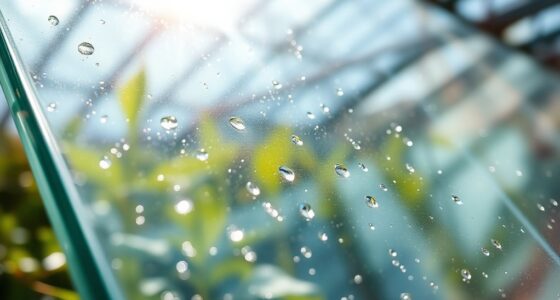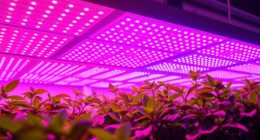If you’re exploring cooling options, evaporative pads and fogging systems are effective and eco-friendly choices. Evaporative pads cool air naturally by drawing warm, dry air through moist filters, lowering temperatures and increasing humidity—great for dry climates. Fogging systems release fine mist to evaporate quickly, absorbing heat and cooling outdoor spaces efficiently. Both solutions are cost-effective and easy to maintain. To discover which option best suits your needs, you’ll find helpful insights as you continue exploring.
Key Takeaways
- Evaporative pads cool air by drawing it through moist filters, lowering temperature and increasing humidity in dry environments.
- Fogging systems release fine water mist that evaporates quickly, effectively reducing outdoor temperatures without wet conditions.
- Both options are energy-efficient and eco-friendly, offering cost-effective cooling solutions compared to traditional air conditioning.
- Evaporative pads are ideal for dry climates, while fogging works well in a broader range of environmental conditions.
- Proper maintenance of pads and fogging equipment ensures optimal performance and system longevity.
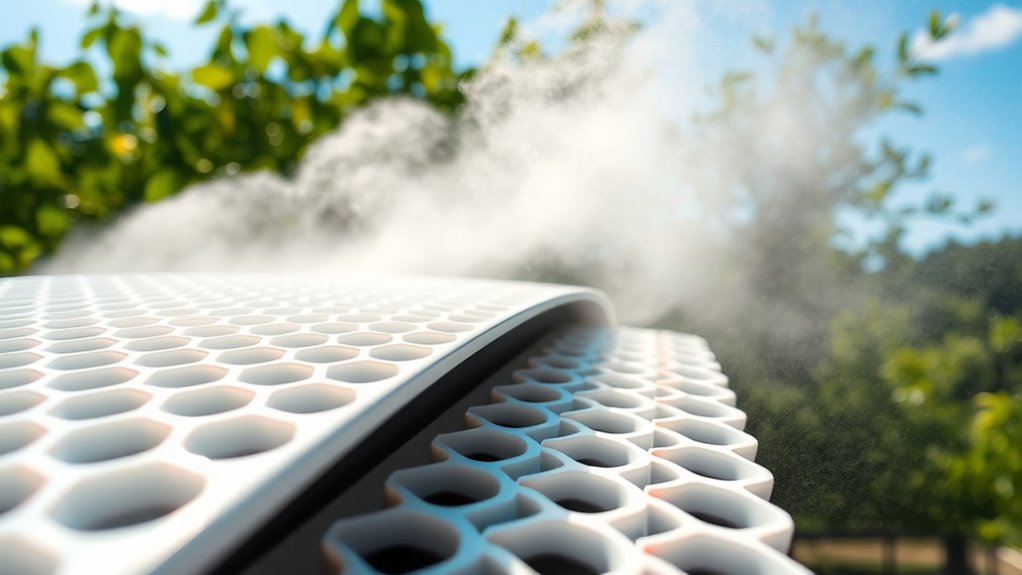
Are you looking for effective ways to keep your space cool? If so, evaporative cooling and fogging systems could be just what you need. These options are especially popular in dry, hot climates because they use natural processes to lower temperatures without relying heavily on traditional air conditioning. Evaporative cooling works by drawing warm, dry air through moist pads, where it absorbs water and cools down before entering your space. This process not only reduces the temperature but also increases humidity, making the environment more comfortable. These evaporative pads are designed to maximize airflow and moisture absorption, ensuring you get a substantial cooling effect with minimal energy use. It’s an eco-friendly and cost-effective alternative to conventional air conditioning units, especially if you’re looking to cut down on electricity bills or want a solution that’s easier on the environment. Regular maintenance of the pads is essential to sustain optimal performance and prolong the lifespan of the system.
Fogging systems, on the other hand, are another efficient cooling option. They operate by releasing a fine mist of water into the air, which quickly evaporates and absorbs heat, thereby lowering the ambient temperature. You’ll often see fogging used in outdoor settings, such as patios, warehouses, or large event spaces, where keeping the air cool is a challenge. These systems are designed to produce a mist that feels almost invisible but is capable of reducing temperatures profoundly. They’re particularly effective in outdoor areas because they can quickly bring down the temperature without creating wet or damp conditions that could be uncomfortable or damaging. Fogging systems are also adjustable, allowing you to control the amount of mist produced, so you can tailor the cooling effect to your specific needs. When selecting a system, consider the climate suitability to ensure maximum efficiency and comfort.
Both evaporative cooling and fogging systems are easy to install and maintain, making them practical solutions for various applications. They’re especially beneficial if you want an energy-efficient way to cool large spaces or outdoor areas. Keep in mind that evaporative cooling is most effective in dry, low-humidity environments, while fogging can work well in a wider range of conditions. When choosing between these options, consider your climate, the size of your space, and your cooling requirements. With either system, you’re opting for a natural, cost-effective way to beat the heat without relying solely on air conditioning. These methods can make a noticeable difference, providing comfort and relief, especially during those scorching summer days.
Frequently Asked Questions
What Are the Environmental Impacts of Evaporative Cooling?
Evaporative cooling offers environmental benefits by using less energy compared to traditional air conditioning, reducing greenhouse gas emissions. However, it does require significant water consumption, which can impact local water resources if not managed responsibly. You can minimize this impact by using efficient systems and recycling water when possible. Overall, evaporative cooling can be eco-friendly if used thoughtfully and with awareness of water use.
How Often Should Fogging Systems Be Maintained?
You should maintain your fogging system every 1 to 3 months, depending on usage and water quality. Following a regular maintenance schedule helps prevent clogging, bacterial growth, and guarantees peak performance. Proper upkeep extends your system’s lifespan and maintains effective cooling. Always clean nozzles, check for leaks, and replace filters as needed. Staying consistent with maintenance is key to getting the most out of your fogging system and avoiding costly repairs.
Are These Cooling Options Suitable for All Climates?
These cooling options aren’t suitable for all climates. Evaporative pads and fogging work best in dry, hot environments with low humidity because they rely on moisture evaporation. In humid regions, their effectiveness diminishes, making them less climate adaptable. Before installing, consider regional suitability and climate adaptability to guarantee these systems will efficiently cool your space without wasting energy or resources.
What Are the Initial Installation Costs?
You’ll find the initial installation costs vary depending on your choices, but generally, evaporative pads are more affordable upfront than fogging systems. A quick cost comparison reveals installation requirements like proper ventilation and water supply influence expenses. Since setup can be straightforward or complex, it’s wise to obtain detailed quotes. This way, you can plan your budget and ensure the system fits your climate and space needs.
Can These Systems Be Integrated With Existing HVAC?
Yes, you can integrate these cooling systems with your existing HVAC, but system compatibility varies. You’ll want to check if your current setup supports retrofit options for evaporative pads or fogging, as some systems may require upgrades or modifications. Consulting a professional will help determine the best approach, ensuring seamless integration and peak performance without disrupting your current climate control.
Conclusion
When choosing between evaporative pads and fogging, you’ll find each has its own perks. Think of it as picking the right tool for the job—you’re the captain steering your comfort ship. Both options can keep things cool, but understanding your space’s needs helps you make the best call. After all, it’s better to have your ducks in a row than to be caught in the heat without a plan. Stay cool and make informed choices!
